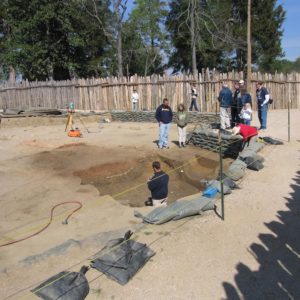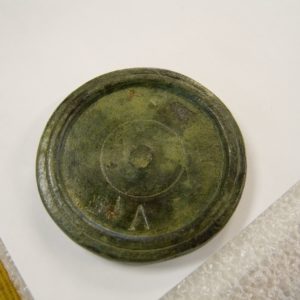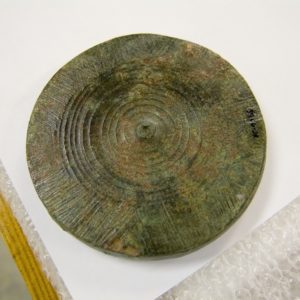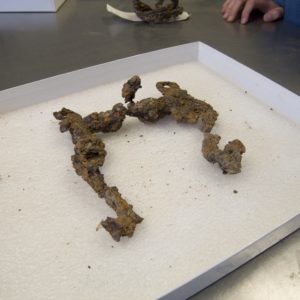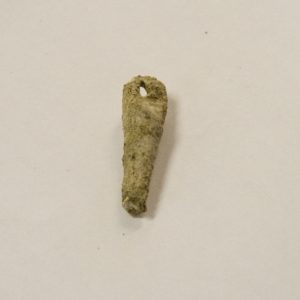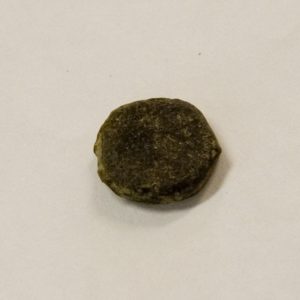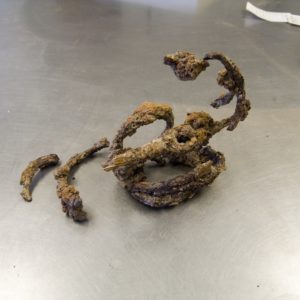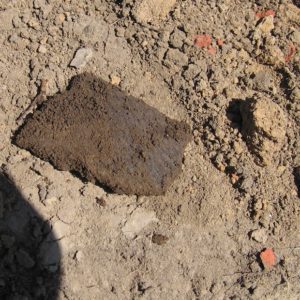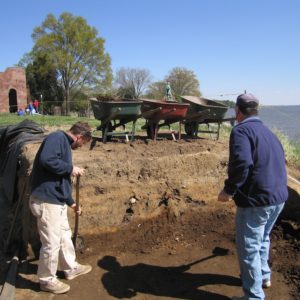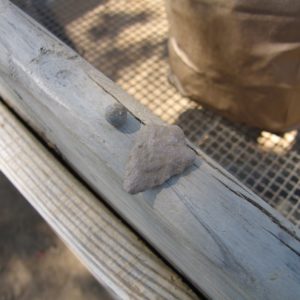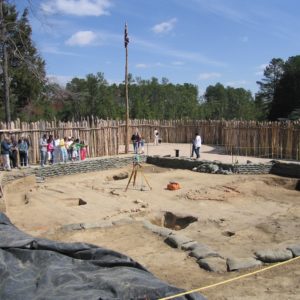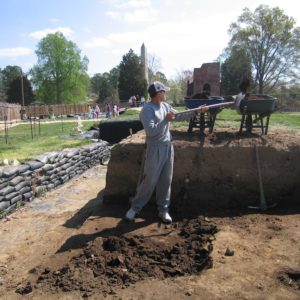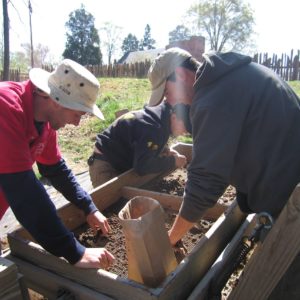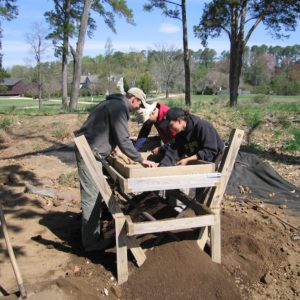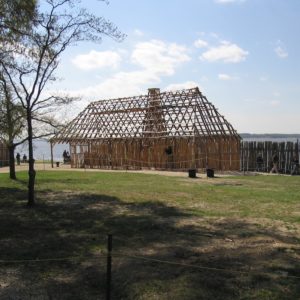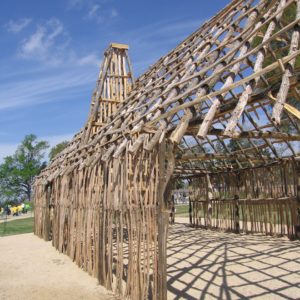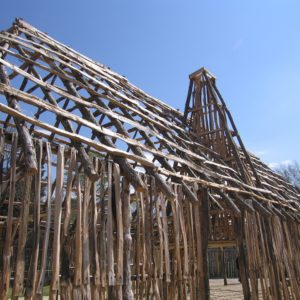Archaeologists excavating an area near the western palisade wall of James Fort are pushing east along the shore of the James River. Excavations in 2005 led to the discovery of several early colonist burials just inside the western palisade wall. Are there more burials in the area? Does the presence of these graves indicate that the fort’s church is nearby? Archaeologists are hopeful that these new excavations will answer these questions and give form to this previously unexcavated section of the fort. Another team of archaeologists is excavating sections of the fort just inside the northern bulwark. Several postholes have been found in an orientation that seems to suggest a fort-period building. A wealth of very early artifacts has been recovered from both areas of the dig that include Virginia Indian projectile points, a cannonball, a rapier hilt, and a horse bridle bit.
Close to where the western bulwark once stood, archaeologists are carefully excavating an area neighboring a series of fort-period graves that were discovered in 2005. The plan is to pick up where 2005’s dig left off by heading east along the seawall that protects the fort from the James River. The archaeologists are curious to see if the previously-discovered burials are part of a larger graveyard. Because graveyards are often placed close to churches, there is some speculation that perhaps evidence of the fort’s first church will be found nearby. Though these excavations are in their beginning stages, several interesting artifacts have been found so far. Sherds of Virginia Indian pottery and a projectile point have been found while screening through the dirt removed from this area. A small lead bullet was also found during the screening process.
Another portion of the dig is focusing on the area just inside the northern bulwark area. Last year, a subterranean feature—possibly another well or a cellar—was in the beginning stages of excavation. In analyzing the surrounding area, archaeologists have found a series of postholes that seem to indicate a structure oriented to the fort wall. The fact that the structure is oriented parallel to the wall is significant because it is evidence that the fort was still standing when the structure was built, suggesting the structure is very early. More evidence for the early nature of this structure exists in the outlines of other early features that cut through or transect this one, making it older than the others (for a more detailed explanation of this phenomenon, please view August 2006’s dig update). The postholes closest to the eastern palisade wall line are about ten feet away from the palisade, which is consistent with other fort-period structures discovered near the palisade walls. The size of the structure is still up in the air because the archaeologists need to determine exactly which postholes are associated with this building. There is a chance, however, that the subterranean feature discovered last year could be part of this structure and may be its cellar.
Excavations in this area have unearthed numerous artifacts including a cannonball, a hammer head, very early case bottle necks, a gaming disc, a plumb bob perhaps to be used as part of a pocket sundial, a horse hoof, and a copper trade weight. Trade weights were used to obtain precise weight measurements in trade transactions. This four-ounce weight has several identifying marks on it that can tell us how it was used and when and where it was made. A prominent ‘A’ represents “Avoirdupois,” the weight system based on a pound equaling sixteen ounces. This system is still used in the United States today. A crowned “EL” stands for Elizabeth I, meaning the weight was created during her reign (1558-1603). Between these two marks is a dagger. This represents the Sword of St. Paul, a London Guildhall mark. Finally, an inverted ewer is a mark of the London Founders Company. Other artifact highlights from this area include a horse bridal bit and a rapier hilt.
Construction is complete on the barracks experimental archaeology project. The entire frame and chimney have been built. The structure is based on archaeological evidence and contemporary examples in Lincolnshire, England that are still standing today. (Learn more about the barracks experimental archaeology project by reading November 2006’s dig update). The structure serves as an interpretive element, giving three dimensions to archaeology which is often very two dimensional to the casual observer. A sense of size is gained through the structure, especially when viewed in relation to the fort’s walls. Visitors can get an idea of the living space the colonists had to deal with when confined to the fort. The barracks experimental archaeology project is also a good springboard to one of the exhibits in the Archaearium, where a section of a mud-and-stud cottage has been built.
New discoveries are being made daily and the experience is shared with the public. Visitors to Historic Jamestowne can watch the archaeologists’ excavations at James Fort and observe as they discover features and uncover artifacts. Afterwards, visitors can view hundreds of the artifacts found there and learn more about the dig and Jamestown’s history at the new Archaearium museum.
related images
- The subterranean feature near the northern bulwark. Further excavations will be needed to determine its form and function.
- Trade weight made in London during the reign of Elizabeth I
- Reverse side of the trade weight. Filings along the edges were made to get its weight down precisely to its needed level
- Rusted horse bridal bit also found in the northern bulwark area
- Plumb bob found in the northern bulwark area. It may have been used as part of a pocket sundial.
- Gaming disc. This small gaming disc would have been used as a game prop.
- A heavily-oxidized rapier hilt found near the northern bulwark. It will take months of conservation to remove the rust.
- A collection of artifacts found in the northern bulwark area. (L-R) A hammer head, two case glass bottle necks, a cannonball, a button and a horse hoof
- A sherd of Virginia Indian pottery found in the western palisade area
- Archaeologists Dave Givens and Dan Smith work to excavate the ground down to the level of the fort period occupation.
- A musket ball and a Virginia Indian projectile point found in the western palisade wall area
- A view of the current excavations
- View of the excavations just inside the northern bulwark
- Archaeologist Don Warmke discusses some of his recent finds with visitors. The crosses mark the burials found in 2005.
- Archaeologist Don Warmke excavates a section of James Fort near colonist burials found in 2005 (marked by crosses at left)
- Archaeologists screen for artifacts in the dirt excavated from the western palisade area
- Screening for artifacts
- The barracks experimental archaeology project
- The barracks experimental archaeology project. Although the chimney was wooden, it would have been lined with clay on the inside to prevent fires.
- A view of the barracks experimental archaeology project



